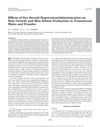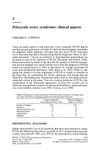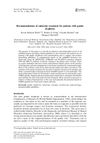Endocrine Intervention for Transsexuals
September 2003
in “
Clinical endocrinology
”
oestradiol valerate spironolactone cyproterone acetate progestogenic drugs finasteride minoxidil hormone therapy thromboembolic events venous thromboembolism bone density breast development pituitary function fertility ovarian histology estradiol valerate Aldactone Androcur Propecia Rogaine hormone treatment blood clots bone health breast growth pituitary gland reproductive health ovary structure
TLDR Hormone treatment for transsexual individuals is effective but carries risks like thromboembolic events and mood changes, with most side effects being minor and reversible.
The document reviewed the diagnosis, assessment, and hormone treatment of transsexual patients, emphasizing the need for a multidisciplinary approach and culturally competent healthcare. It detailed hormone treatments for male-to-female and female-to-male transitions, noting the variability in effects and the necessity for individualized regimens. Risks included increased suicide rates, depressive mood changes, thromboembolic events, and specific health issues like hepatitis B and cholelithiasis. Estrogen treatment prevented bone mineral density loss in male-to-female transsexuals, while testosterone treatment in female-to-male transsexuals had mixed results. The document also discussed the legal and social challenges faced by transsexual individuals and concluded that adequately treated gender dysphoria was likely safer than untreated, with few transsexuals regretting their treatment.





